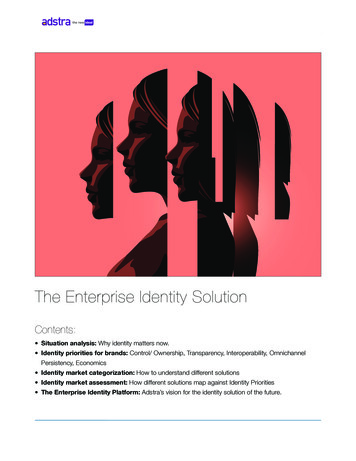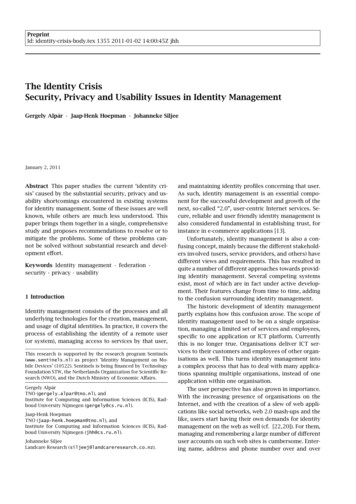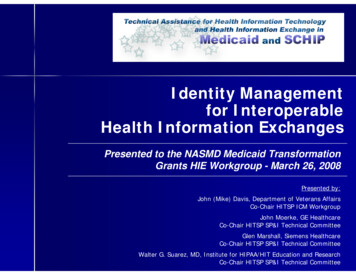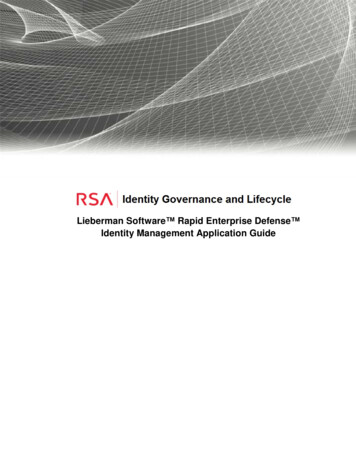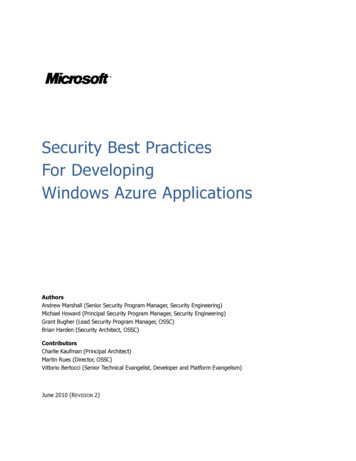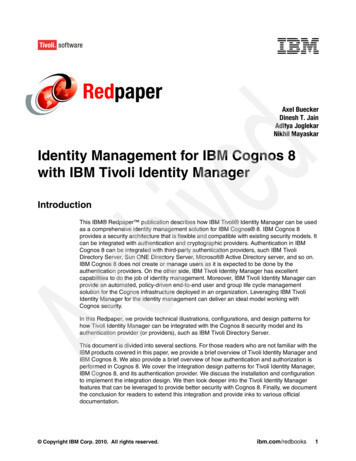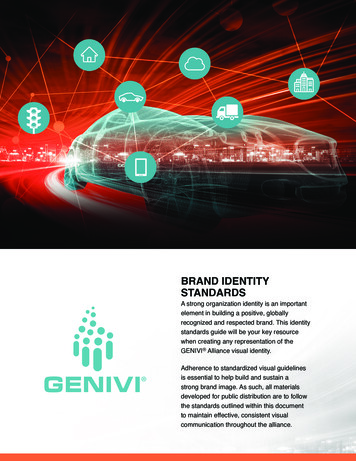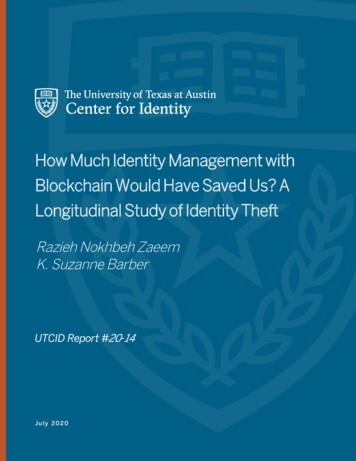
Transcription
How Much Identity Management withBlockchain Would Have Saved Us? ALongitudinal Study of Identity TheftRazieh Nokhbeh ZaeemK. Suzanne BarberUTCID Report #20-14July 2020
How Much Identity Management with Blockchain WouldHave Saved Us? A Longitudinal Study of Identity TheftAbstractThe use of blockchain for identity management (IdM) has been on the rise in the past decade. Wepresent the first work to study the actual, large-scale impact of using blockchain for identitymanagement, particularly how it can protect Personally Identifiable Information (PII) to curbidentity theft and fraud. Our insight is that if blockchain-based IdM protects PII, it can reduce thenumber of theft and fraud cases that take advantage of such PII. At the Center for Identity at theUniversity of Texas at Austin, we have modeled about 6,000 cases of identity theft, and PIIexploited in them. We utilize this model to investigate how three real-world blockchain-basedIdM solutions (Civic, ShoCard, and Authenteq) could have reduced the identity theft loss overthe past 20 years if they had been universally used. We identify which PII protected byblockchain is more critical. We also suggest new PII to include in blockchain-based IdM. Ourwork paves the way for the design of more effective blockchain-based IdM or any other new lineof IdM for that matter.Key Takeaways The Center for Identity present’s the first work to study the actual, large-scale impact ofusing blockchain for identity management, particularly how it can protectPersonally Identifiable Information (PII) to curb identity theft and fraud.UT CID has modeled approximately 6,000 cases of identity theft, along with the PIIexploited in them.This model was then used to investigate how three real-world blockchain-based IdMsolutions (Civic, ShoCard, and Authenteq) could have reduced the identity theft loss overthe past 20 years.The research finds that that some PII are more important to protect: complete protectionof Social Security Card, for example, would have eliminated about 10% of all theincidents we recorded and modeled.This report also recommends new PII to add to blockchain-based IdM solutions: mostnotably Financial Information, e.g., Debit/Credit Card, Bank Account, and TaxpayerInformation.Copyright 2021. The Center for Identity. All rights reserved.
How Much Identity Management withBlockchain Would Have Saved Us? ALongitudinal Study of Identity TheftRazieh Nokhbeh Zaeem1[0000 0002 0415 5814] and K. Suzanne Barber1The Center for Identity, The University of Texas at Austin, Austin, TX 78712, ntity.utexas.eduAbstract. The use of blockchain for identity management (IdM) hasbeen on the rise in the past decade. We present the first work to study theactual, large-scale impact of using blockchain for identity management,particularly how it can protect Personally Identifiable Information (PII)to curb identity theft and fraud. Our insight is that if blockchain-basedIdM protects PII, it can reduce the number of theft and fraud cases thattake advantage of such PII. At the Center for Identity at the Universityof Texas at Austin, we have modeled about 6,000 cases of identity theft,and PII exploited in them. We utilize this model to investigate howthree real-world blockchain-based IdM solutions (Civic, ShoCard, andAuthenteq) could have reduced the identity theft loss over the past 20years if they had been universally used. We identify which PII protectedby blockchain is more critical. We also suggest new PII to include inblockchain-based IdM. Our work paves the way for the design of moreeffective blockchain-based IdM or any other new line of IdM for thatmatter.Keywords: Identity Management · Blockchain · Identity Theft · SelfSovereign Identity.1IntroductionThe blockchain technology has found a variety of applications beyond cryptocurrency, from insurance to the Internet of Things. One of these applications isIdentity Management (IdM), the framework that identifies, authenticates and authorizes users in order to control access to resources. Many concrete blockchainbased IdM solutions exist today, ranging from successful startups to open sourceprojects and foundations.One of the most prominent goals of IdM, when utilized to manage PersonallyIdentifiable Information (PII) (such as email addresses, passwords, fingerprints,and driver’s licenses), is to protect PII from identity theft and fraud. Identitytheft and fraud is the fraudulent acquisition and use of such PII. According tothe latest statistics from the U.S. Department of Justice published in 2019 [8],
Identity Management with BlockchainZaeem and Barber10% of all U.S. residents reported that they had been victims of identity theftin 2016 with a total loss of 17.5 billion.Blockchain-based IdM solutions offer user control, decentralization, immutability, transparency, security, and privacy for the PII they manage–added propertiesthat can prevent identity theft and fraud. The actual effect of these solutions onthe landscape of identity theft and fraud, however, has not received the attentionit deserves.We present the first work to examine the large-scale effect of this new typeof IdM through the lens of a longitudinal study of close to 6,000 cases of identitytheft and fraud, which took place over the past 20 years. We estimate the potential of blockchain-based IdM in preventing identity theft and fraud, based onits ability to protect PII leveraged in identity management. Our insight is thatif blockchain-based IdM secures and protects some types of PII, it can eliminate(or substantially reduce) the number of theft and fraud cases that take advantage of those types of PII. Consequently, it can prevent millions of dollars of lossthat harm identity theft victims every year.We make the following contributions:1. We introduce the idea of extrapolating from previous identity theft and fraudcases to study the future effect of blockchain-based IdM.2. We take advantage of our longitudinal study of the past 20 years of newsreporting on identity theft and fraud—modeled by a team of modelers atthe University of Texas at Austin Center for Identity in over six years. Weinvestigate the frequency, monetary loss, and other properties of identitytheft cases involving PII that could be protected with blockchain-based IdM.We discover that while blockchain-based IdM cannot eliminate identity theftand fraud altogether, its effective protection of PII such as Social Security Cardcan potentially end millions of dollars of identity theft loss. The protectionblockchain-based IdM solutions extend to some PII is more valuable than others.Reducing the chance of exposure of these PII (Social Security Card, HealthcareID and Driver’s License) would have saved identity theft victims from the highestamount of loss in the past 20 years.Based on our study of the identity theft cases, we recommend new PII toinclude in blockchain-based IdM to further mitigate the effect of identity theft.Some of the most prominent PII we suggest include: Financial Information suchas Banking, Credit/Debit Card, and Taxpayer Information as well as EmployerInformation and ID.Our work sheds light on actual, large-scale potential of new IdM solutions,with a focus on blockchain-based IdM. Our results enlighten developers of newIdM and their users and scientifically direct these efforts to maximize their impact. Furthermore, once new blockchain-based IdM is widely used, we can studyits actual effect on the landscape of identity theft and fraud through the samemethodology of examining reported identity theft cases.Copyright 2021. The Center for Identity. All rights reserved.
Identity Management with Blockchain2Zaeem and BarberRelated Work: Identity Management with BlockchainIn this section we explain fundamentals of blockchain and blockchain-based IdM,review commercially available examples of such IdM solutions, and cover relatedwork on the actual large-scale benefits of migrating to IdM with blockchain.2.1BlockchainThe term blockchain is rooted in the seminal Bitcoin white-paper [12] that introduced a novel crypto-currency (i.e., electronic cash) technology. This technology allows online transactions to take place without the need to go througha trusted financial third party. Digital signatures and a peer-to-peer networkform the backbone of the Bitcoin technology. The two parties of the transaction communicate through digital signatures (i.e., public and private keys). Thepeer-to-peer network timestamps transactions by hashing them into a chain ofblocks, forming a record of transactions. The longest chain of blocks serves asa tamper-proof ledger of all witnessed transactions. This ledger (also known asblockchain) cannot be altered without the consensus of the network majority.2.2Blockchain-Based Identity ManagementThe blockchain technology has been used for a whole host of applications [10],including identity management (IdM). IdM is the framework that identifies,authenticates, and authorizes users to access resources. Blockchain-based IdMsolutions [18] adopt blockchain for identity management.In an IdM, when the user needs to make a claim (i.e., assert something aboutone’s identity, like the citizenship of a country), he/she provides an identityproof (i.e., some form of document that provides evidence for the claim, like apassport). Identity proofs always contain PII, i.e., any information that couldbe used to identify an individual. Such identity proofs should be attested (i.e.,validated) by the relevant identity authority (e.g., the agency that issued thepassport).Blockchain-based identity solutions encrypt a user’s identity, hash it, andadd its attestations to the blockchain ledger. These attestations are later usedin order to prove the user’s identity. Two categories of blockchain-based IdMsolutions exist [7]:1. Decentralized Identity (e.g., ShoCard, Authenteq, BitID, ID.me, and IDchainZ): This identity solution is similar to conventional identity management solutions where credentials from a trusted service are used. The onlydifference arises is the storage of validated attestations on a distributedledger for later validation by a third party.2. Self-sovereign identity (e.g., Civic, Sovrin, uPort, and Onename.io): Theuser owns and controls his/her identity without heavily relying on centralauthorities. In essence, self-sovereign identity is very similar to how nondigital identity documents work today. Every user keeps their own identityCopyright 2021. The Center for Identity. All rights reserved.
Identity Management with BlockchainZaeem and Barberdocuments in their device. The user creates a public/private key pair andcontacts identity authorities to associate and attest his/her public key withan identity proof. When the user makes a claim, the user provides his/herattested public key. The verifier accepts only the claims signed with theuser’s private key.Blockchain-based IdM improves identity management in several ways. Digitalsignatures, one of the major components of the blockchain technology, provideauthenticity of the identity proof and attestation. The peer-to-peer network, theother major component of blockchain, eliminates the need for a central repository of users’ identity. Hence, blockchain can make IdM solutions decentralized,tamper-resistant, and enhance security and privacy.2.3Examples of Commercially Available IdM SolutionsMany foundations, companies, startups, and open source projects have utilized [9] blockchain for identity management. In this work, we have studieddifferent blockchain-based IdM services offered by multiple companies like Authenteq [2], ShoCard [3], and Civic [1]. In all these services, the user first logs intothe web/mobile app, and provides email address and phone number to createan account. The user then selects which government-issued identity documentsto use for identity verification, e.g., Passport, National Identity Card, Driver’sLicense, or Social Security Card as shown in Table 1. The user scans one ofthese identity verification documents and the app verifies the document againsta third party. After the check, the user identity is confirmed, attested on theblockchain and can be reused.Table 1. Identity document options in three blockchain identity management solutions.CivicShoCardAuthenteqPassportSocial Security Card (SSC) Any Government IDNational Identity Card (NID) Green Card (GC)Driver’s LicenseHealth Card/Photo ID2.4Evaluation of Blockchain-Based IdM SolutionsThere are very few studies evaluating blockchain-based IdM solutions. For example, Baars [4] studied ten blockchain-based identity management systems toidentify their properties and compare them together. These ten solutions wereOnename.io, Qiy, iDIN, eHerkenning, IRMA, PKIoverheid, Jumio, Tradle, Idensys, and uPort. Dunphy and Petitcolas [7] used the laws of identity frameworkCopyright 2021. The Center for Identity. All rights reserved.
Identity Management with BlockchainZaeem and Barber(including user control and consent, minimal disclosure, justifiable parties, directed identity, design for a pluralism of operators, human integration, and consistent experience across contexts) to evaluate three blockchain-based IdM solutions (uPort, ShoCard, and Sovrin).Our previous work [14] investigated different PII options given to users forauthentication on current blockchain-based IdM solutions. Based on our Identity Ecosystem model [15, 13, 5, 6, 11], we evaluated these options and their riskand liability of exposure. Powered by real world data of about 6,000 identitytheft and fraud stories from ITAP (Section 3), our model recommended someauthentication choices and discouraged others.None of these studies, however, have looked at the potential large-scale effectof this new line of IdM solutions. In this work, we investigate how the addedsecurity and privacy of blockchain-based IdM can thwart identity theft. Clearly,using blockchain would not eliminate all identity theft nor it would fully protectidentity documents. There still exists a chance that the device containing theidentity proof falls into the wrong hands and one poses as the identity owner.With that said, we can still estimate the potential of blockchain-based IdM inreducing the effect of identity theft since it dramatically reduces the chance ofcompromise for the identity proof/PII. Assuming that blockchain-based IdMprotects the identity proof/PII, we approximate how much these IdM solutionswould have saved identity theft victims by eliminating identity theft and fraudcases that happened because a particular identity proof/PII was stolen/misused.3Identity Threat and Assessment Prediction (ITAP)In order to estimate the potential of blockchain-based IdM in reducing financialloss of identity theft, we need a database of identity theft and fraud cases thatrecords details of such cases and spans a long period of time and a diverse setof victims. Our Identity Threat and Assessment Prediction (ITAP) project [17,16] is such a longitudinal study of identity theft and fraud cases.ITAP is a structured database of news stories that gathers and models dataabout incidents of identity theft, fraud, and abuse. Through these news stories,we seek to determine the methods and resources used to carry out these crimes,the vulnerabilities exploited, and the consequences of these incidents. The ITAPmodel is a large and continually growing, structured repository of such information. ITAP spans national and international identity theft cases over the past 20years (2000-2020) and currently includes 5,906 unique identity theft incidents.In order to populate ITAP, using a wide variety of online sources, we gatherthe data from news stories that report on incidents involving the exposure, theft,or fraudulent use of PII such as names, social security numbers, and credit cardnumbers. We find candidate news stories in two ways: via an RSS feed set upthrough Feedly1 and via several Google Alerts2 based on relevant key /alertsCopyright 2021. The Center for Identity. All rights reserved.
Identity Management with BlockchainZaeem and BarberWe regularly monitor the stories thus gathered and store those that we deemappropriate for ITAP.A team of modelers record salient information about these incidents. Therecorded information about identity thieves includes:1. Performers: the performers of the identity theft incident, including thief,frustrater, abuser, or non-malicious actor.2. Inputs: PII that the performers initially obtained and used.3. Outputs: PII that the performers created, acquired, or exposed based on theinputs.4. Resources: The types of tools, devices, applications, and other instrumentsused by the performers in carrying out the incident.5. Steps: The steps that the performers took.6. Criminal Activities: The relationship between the performers and the victims, e.g., insider, outsider, or both.The information collected about victims includes:1.2.3.4.5.6.7.8.9.Age Group of Victims.Gender of Victims.Citizenship of Victims.Education Level of Victims.Annual Income of Victims.Profession of Victims.Organization Affected.Sector of Society or Infrastructure Involved.Counter Measures Taken by the Victim Organization.Finally, the information about the incident itself includes:1.2.3.4.5.6.7.4Location of the Event, or the “Internet”.Date When Event Occurred.Date of Article or Announcement.Type of Loss Incurred, e.g., emotional, reputation, or financial.Financial Loss Amount (converted to US Dollars).Reputation Loss.Emotional Distress.Experimental ResultsIn this work, we seek to answer the following main research question: What isthe potential of the blockchain-based identity management solutions (namelyCivic, ShoCard, and Authenteq) in thwarting identity theft? For example, howmuch financial damage would have been avoided if all the ITAP identity theftand fraud cases that have a Social Security Number as input where eliminated,because the owner protected his/her Social Security Number with blockchainbased identity management? In order to answer this question, we report statisticsfrom ITAP to answer the following research questions (RQ):Copyright 2021. The Center for Identity. All rights reserved.
Identity Management with BlockchainZaeem and Barber1. How many cases have at least one PII input that could be protected withblockchain-based IdM (Table 1)?2. What is the average financial cost of those cases?3. What are other PII that could be added to blockchain-based IdM to prevent(a) high-loss identity theft incidents?(b) frequent identity theft incidents?We retrieved the list of PII involved in ITAP identity theft and fraud cases(i.e., all PII that thieves and fraudsters used as inputs to carry out the incidentsor expose/generate other PII as well as all PII that they exposed or fraudulentlygenerated as outputs) and manually scanned them for relevant PII according toTable 1. Table 2 lists these PII and shows which IdM solution could possiblyprotect them.4.1RQ1: How many cases have at least one input PII that couldbe protected with blockchain-based IdM?There are a total of 5,906 identity theft and fraud cases in ITAP, and Table 3shows how many of those cases have at least one input PII from a given categoryof PII. (Categories of PII are shown in Tables 1 and 2.) Note that Green-Cardrelated PII (e.g., Visa Details) happen to appear only as output in the currentset of ITAP cases, and therefore have zero cases in which they are PII inputs.Also, there are only two cases with National ID as their input PII, none ofwhich report their financial loss. As a result, we cannot calculate the averageloss for the Green Card and National ID categories of PII. This might be due tothe fact that ITAP is predominantly U.S.-oriented, where Visa and National IDcontribute to a very small number of identity theft cases.It is clear from the number of cases reported in Table 3 compared to thetotal number of 5,906 cases in ITAP that blockchain-based IdM solutions donot eliminate all identity theft and fraud, even if universally applied to protectthe PII these solutions do cover. These IdM solutions, however, would save theidentity theft and fraud victims from considerable amount of financial loss.4.2RQ2: What is the average financial cost of preventable cases?Most of the PII categories of Table 3 pertain to an average loss amount of over 1M (not averaged per victim but per incident3 ). For example, if all PII of thePassport category (including Passport Information, Number, Expiration Date,and Country of Issue) where protected with blockchain-based IdM, 16 identitytheft cases of ITAP with an average loss value of 1,252,464 would have beenavoided because at least one of their input PII would not be compromised.The Social Security Card PII category (including Social Security Number,Suffix, and Social Security Card) is the input to 567 cases with an average3We did not calculate the average loss per victim because the number of victims isusually not reported in the identity theft and fraud news story.Copyright 2021. The Center for Identity. All rights reserved.
Identity Management with BlockchainZaeem and BarberAuthenteqCivicGC Passport NID Driver’s LicenseOther Gov. IDDriver’s License NumberDriver’s License InformationStolen Driver’s License InformationFake Driver’s License InformationDriver’s License PhotoDriver’s License Expiration DateGovernment Issued ID NumberState Identification NumberID Card NumberUniversal ID NumberID Card InformationAadhaar Unique Identification Number (India)Personal Record Identifier (PRI) (Canada)DNI (Documento Nacional de Identidad - Spain) InformationSSCPassport InformationPassport NumberPassport Expiration DatePassport Country of IssueNational Identity NumberGov. Health IDInsurance Policy InformationHealth Plan Member NumberHealth Insurance Policy NumberIndividual Healthcare PlanHealth Insurance Policy InformationHealthcare Provider’s NameMedical ID NumberHealthcare Provider InformationHealth Insurance ID Card InformationHealth Plan Group NumberHealth Insurance Company NameMedicare Provider ID NumberMedicaid ID NumberMedicare ID NumberMedicaid Provider ID NumberNational Health Index Number (New Zealand)Social Security Number (SSN)SSN Suffix (Last Four Digits)Social Security Number - InvalidVisa DetailsPrivate Health IDShoCardTable 2. PII that could be protected with the blockchain-based IdM solutions Civic,ShoCard, and Authenteq, as found in the ITAP repository.Copyright 2021. The Center for Identity. All rights reserved.
Identity Management with BlockchainZaeem and Barberfinancial loss of over 27M. To provide some context, Social Security Number isone of the PII involved in the highest loss value cases: the average loss value ofall the ITAP cases is just over 11M, while Social Security Card and Numbercases have an average loss of over 27M.4.3RQ3: What are other PII to add to blockchain-based IdM?Top 5% PII/identity proof documents in terms of feeding input to high-lossidentity theft incidents are as follows:– Financial Information, including Credit Card Information, and TaxpayerInformation such as Electronic Filing Identification Number (EFIN)– Social Security Number– Employer Information and ID– Medicare ID NumberSocial Security Number and Medicare are already included in many blockchainbased IdM solutions. We recommend further addition of Credit Card Informationand Taxpayer Information, as well as Employer Identification to avert high-lossidentity theft and fraud.Top 5% PII/identity proof documents frequently involved as input to incidents are as follows:– Social Security Number– Financial Information, e.g., Credit/Debit Card, Bank Account, and Taxpayer Information– Driver’s License Information– Patient Medical RecordThese frequently abused PII have a considerable overlap with PII involved inhigh-loss incidents. We reiterate that one category of PII/identity proof that westrongly recommend adding to blockchain-based IdM is Financial Information,e.g., Debit/Credit Card, Bank Account, and Taxpayer Information. In fact, theinvestigation of the websites of Authenteq, Civic, and ShoCard shows they areplanning to include this information in their IdM solutions.Table 3. The number of ITAP cases that have a PII protected with the blockchainbased IdM solutions Civic, ShoCard, and Authenteq, as input.IdMPII hSecurityIDCardGreen PassportCard# Cases 28195670Avg. Loss 1,661,308 4,052,047 27,465,086 N/ACivicNational Driver’sIDLicense162 1,252,464 N/ACopyright 2021. The Center for Identity. All rights reserved.OtherGov.ID8642 1,751,281 492,459
Identity Management with Blockchain5Zaeem and BarberConclusion and Future WorkWe presented the first work in the literature that investigated the real-world,large-scale impact of blockchain-based IdM on identity theft and fraud. We utilized a model of about 6,000 reported identity theft and fraud cases that occurredin the past 20 years (from 2000 to 2020), and estimated how much blockchainbased IdM solutions (Civic, ShoCard, and Authenteq) could have saved identitytheft victims, if they had been used. We found that some PII are more important to protect: complete protection of Social Security Card, for example, wouldhave eliminated about 10% of all the incidents we recorded and modeled, withan average monetary loss of over 27M per incident. We also recommended newPII to add to blockchain-based IdM solutions: most notably Financial Information, e.g., Debit/Credit Card, Bank Account, and Taxpayer Information. Ourresults are useful to developers of new this new line of IdM and their users.In the future, we can retrospectively evaluate the effect of the universal use ofblockchain-based IdM through the same methodology, once it is widely adopted.6AcknowledgmentsThis work was in part funded by the Center for Identity’s Strategic Partners. Thecomplete list of Partners can be found at rences1. /, (Accessed on 04/11/2019)2. Identity verification & KYC, authenteq. https://authenteq.com/, (Accessed on04/11/2019)3. Shocard identity management use cases — shocard. https://shocard.com/identitymanagement-use-cases/, (Accessed on 04/11/2019)4. Baars, D.: Towards self-sovereign identity using blockchain technology. Master’sthesis, University of Twente (2016)5. Chang, K.C., Zaeem, R.N., Barber, K.S.: Enhancing and evaluating identity privacy and authentication strength by utilizing the identity ecosystem. In: Proceedings of the 2018 Workshop on Privacy in the Electronic Society. pp. 114–120 (2018)6. Chang, K.C., Zaeem, R.N., Barber, K.S.: Internet of things: Securing the identityby analyzing ecosystem models of devices and organizations. In: 2018 AAAI SpringSymposium Series. pp. 111–116 (2018)7. Dunphy, P., Petitcolas, F.A.: A first look at identity management schemes on theblockchain. IEEE Security & Privacy 16(4), 20–29 (2018)8. Erika Harrell, Ph.D., B.o.J.S.: Victims of identity theft (2016, revised in 2019)9. Jacobovitz, O.: Blockchain for identity management. The Lynne and WilliamFrankel Center for Computer Science Department of Computer Science. BenGurion University, Beer Sheva (2016)10. Lakhani, K.R., Iansiti, M.: The truth about blockchain. Harvard Business Review95, 118–127 (2017)Copyright 2021. The Center for Identity. All rights reserved.
Identity Management with BlockchainZaeem and Barber11. Liau, D., Zaeem, R.N., Barber, K.S.: Evaluation framework for future privacyprotection systems: A dynamic identity ecosystem approach. In: 2019 17th International Conference on Privacy, Security and Trust (PST). pp. 1–3. IEEE (2019)12. Nakamoto, S.: Bitcoin: A peer-to-peer electronic cash system (2008). Tech. rep.,Manubot (2019)13. Rana, R., Zaeem, R.N., Barber, K.S.: Us-centric vs. international personally identifiable information: A comparison using the ut cid identity ecosystem. In: 2018 International Carnahan Conference on Security Technology (ICCST). pp. 1–5. IEEE(2018)14. Rana, R., Zaeem, R.N., Barber, K.S.: An assessment of blockchain identity solutions: Minimizing risk and liability of authentication. In: 2019 IEEE/WIC/ACMInternational Conference on Web Intelligence (WI). pp. 26–33. IEEE (2019)15. Zaeem, R.N., Budalakoti, S., Barber, K.S., Rasheed, M., Bajaj, C.: Predictingand explaining identity risk, exposure and cost using the ecosystem of identity attributes. In: 2016 IEEE International Carnahan Conference on Security Technology(ICCST). pp. 1–8. IEEE (2016)16. Zaeem, R.N., Manoharan, M., Yang, Y., Barber, K.S.: Modeling and analysis ofidentity threat behaviors through text mining of identity theft stories. Computers& Security 65, 50–63 (2017)17. Zaiss, J., Nokhbeh Zaeem, R., Barber, K.S.: Identity threat assessment and prediction. Journal of Consumer Affairs 53(1), 58–70 (2019)18. Zyskind, G., Nathan, O., et al.: Decentralizing privacy: Using blockchain to protectpersonal data. In: 2015 IEEE Security and Privacy Workshops. pp. 180–184. IEEE(2015)Copyright 2021. The Center for Identity. All rights reserved.
W W W. ID EN TIT Y.U T E X AS . ED UCopyright 2020 The University of Texas Confidential and Proprietary, All Rights Reserved.
2.2 Blockchain-Based Identity Management The blockchain technology has been used for a whole host of applications [10], including identity management (IdM). IdM is the framework that identi es, authenticates, and authorizes users to access resources. Blockchain-based IdM solutions [18] adopt blockchain for identity management.
